As an art teacher, your primary goal is to foster creativity and encourage your students to express themselves through art. However, it’s important to remember that the art classroom can also present unique safety hazards that require proper precautions. One way to ensure a safe and secure creative space is by having a well-equipped first aid kit on hand at all times.
A well-stocked first aid kit can make all the difference in addressing accidents or emergencies that may occur while engaging in artistic activities. From minor cuts and burns to more serious injuries, having the appropriate supplies readily available can help mitigate any harm and ensure that both you and your students remain safe and comfortable in the art classroom.
Key Takeaways:
- Art classrooms present unique safety hazards and require proper precautions to ensure a safe and secure creative space.
- A well-equipped first aid kit is essential for addressing accidents or emergencies that may occur while engaging in artistic activities.
- Having the appropriate supplies readily available can help mitigate any harm and ensure that both you and your students remain safe and comfortable in the art classroom.
Understanding the Unique Risks in an Art Classroom
As an art teacher, you know that the art classroom is a unique space that requires distinct safety measures and precautions. Art students work with a range of materials and equipment that can pose significant risks if not handled properly. That’s why it’s essential to have safety supplies for art teachers and Art Room First Aid Kits that cater to the specific needs of a creative space.
Art classrooms pose unique risks not found in other educational environments. Cuts, burns, and exposure to toxic materials are just some of the hazards that art teachers may encounter. It’s essential to be aware of these risks and the potential harm they can cause to yourself, your students, and colleagues.
Safety Supplies for Art Teachers must be specifically designed to cater to the unique requirements of an art studio. These supplies must include adequate Personal Protective Equipment (PPE) such as gloves and aprons to prevent skin contact with hazardous materials.
To minimise potential injury and respond swiftly in case of emergency, it’s also essential to have a first aid kit that caters to the specific risks of the art classroom. These kits must include items like sterile dressings, burn cream, eye wash, and emergency blankets to treat a range of injuries.
In short, being aware of the unique risks posed by the art classroom and providing First Aid for Creative Spaces can make all the difference between a productive and safe environment and a disaster.
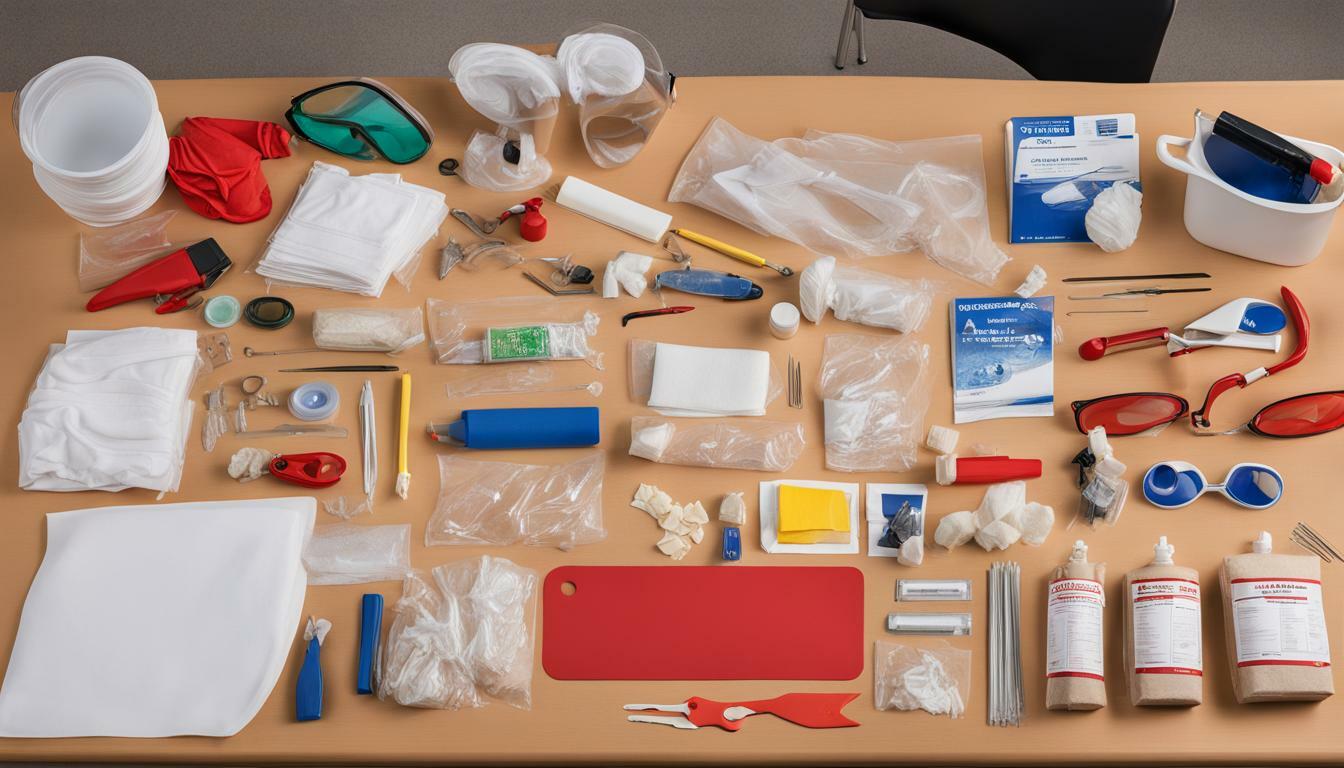
Building a Comprehensive First Aid Kit
When it comes to first aid kits for art teachers, it’s important to have one that is specifically tailored to the unique risks and hazards that come with working in an art studio. In addition to the standard first aid supplies like adhesive bandages and sterile dressings, there are other items that should be included in a comprehensive first aid kit for art teachers.
Here are some safety equipment for art teachers and art studio first aid supplies you should consider including in your first aid kit:
| Item | Purpose |
|---|---|
| Burn cream | To treat minor burns, which are common in art studios. |
| Eye wash | To flush out any chemicals or debris that may have gotten into the eyes. |
| Disposable gloves | To protect the person administering first aid and the person receiving it from any bodily fluids or other contaminants. |
| Tweezers | To remove splinters or other foreign objects from the skin. |
| Allergy medication | To treat any allergic reactions that may occur from exposure to certain materials or chemicals. |
It’s important to regularly check and replenish your art studio first aid supplies to make sure they’re all still viable and up-to-date. You can do this by designating one person to be in charge of the first aid kit and checking it every few months or whenever supplies are used up. Additionally, consider storing your first aid kit in a visible and easily accessible location so that it can be quickly accessed in case of emergency.
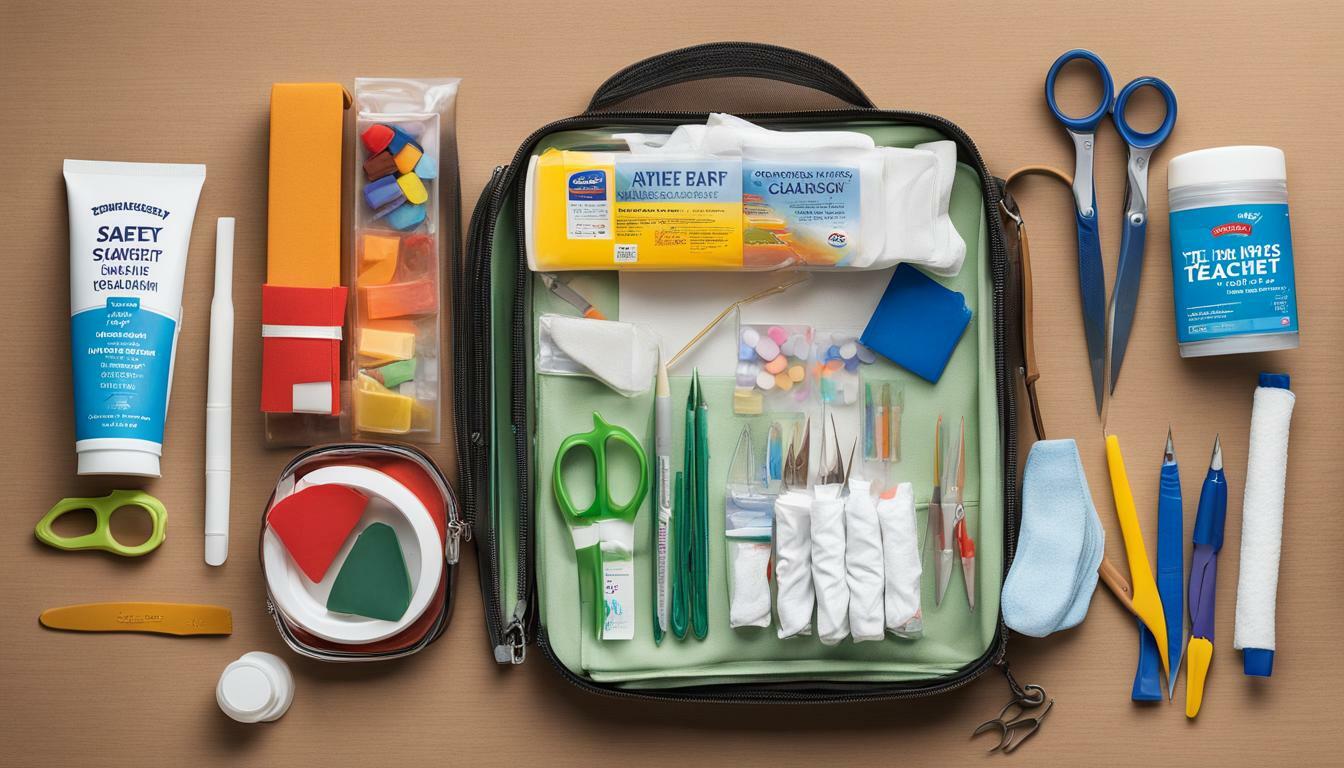
Addressing Common Art Classroom Injuries
Art classrooms can present a range of hazards for students and teachers alike. Cuts, burns, and allergic reactions are some of the most common injuries that can occur in an art classroom. It is essential for art teachers to have a well-stocked first aid kit and the knowledge necessary to address these injuries promptly and effectively.
If a student suffers a cut, the first step is to clean the wound thoroughly with soap and water. Once the area is clean, apply direct pressure using a sterile dressing to stop any bleeding. If the cut is deep, seek medical attention immediately.
Burns are another common injury in art classrooms. If a student sustains a burn, the first step is to run cool water over the affected area for at least 10 minutes. This will help to alleviate pain and reduce the risk of scarring. For more severe burns, cover the area with a sterile dressing and seek medical attention immediately.
Allergic reactions can occur when students are exposed to certain materials, such as latex. If a student experiences an allergic reaction, it is essential to remove them from the source of the allergen immediately. Administer antihistamines if available and seek medical attention immediately.
Remember, in the event of an emergency, call for help immediately. A first aid kit can only do so much, and some injuries require medical attention beyond what can be provided in the art classroom.
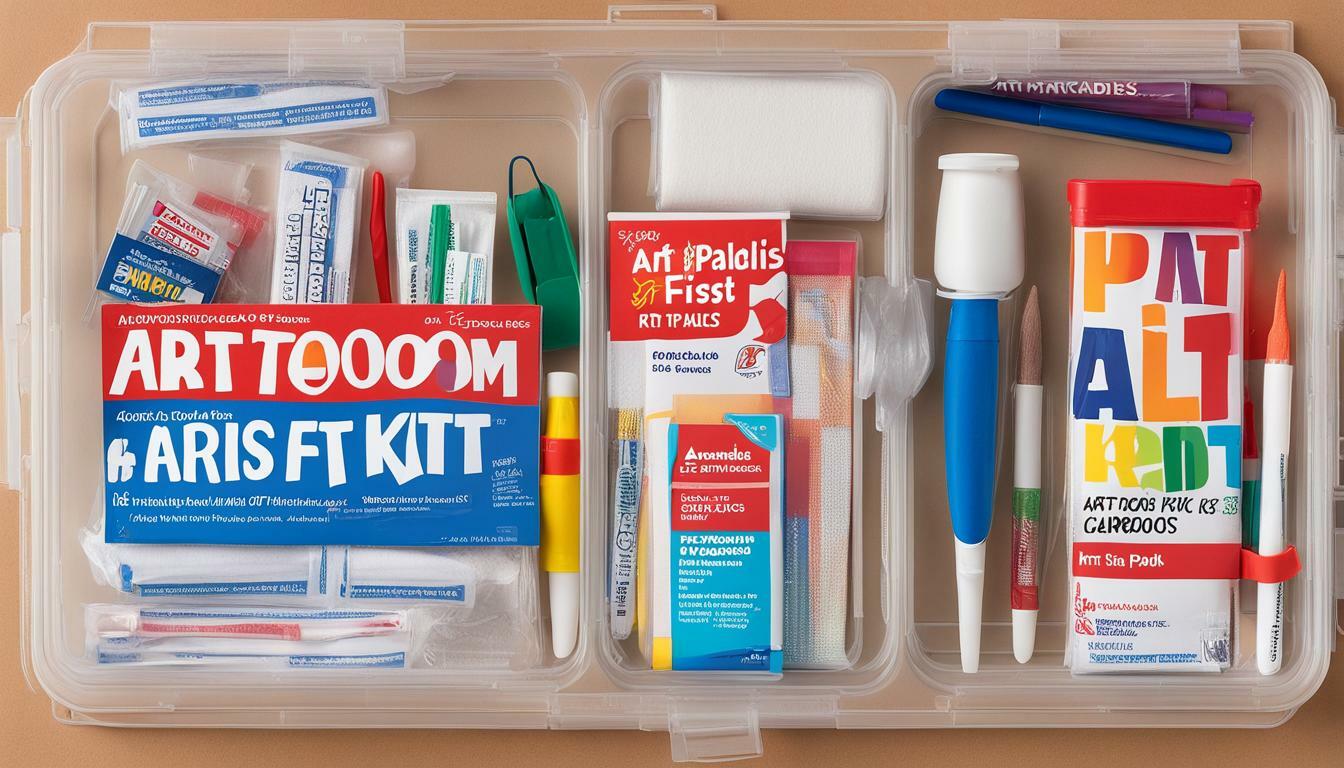
“Injuries can happen in any classroom, but it is essential for art teachers to be prepared for the unique hazards present in an art studio. A well-stocked first aid kit and knowledge of basic first aid can make all the difference.”
First Aid Training for Art Teachers
While having a well-stocked first aid kit is essential in ensuring the safety of art teachers and their students, it is equally important for art teachers to receive first aid training. A basic understanding of first aid can equip art teachers with the knowledge and confidence to respond to emergencies effectively.
Art teachers should consider taking relevant courses that cater to their needs, such as Emergency First Aid at Work for Teachers. These courses cover essential first aid skills, including CPR, treating wounds, and managing allergic reactions. By acquiring these skills, art teachers can act swiftly and confidently during emergencies, potentially saving lives.
Additionally, art teachers can refresh their knowledge periodically by attending refresher courses or practicing their skills with colleagues. By remaining up to date with the latest first aid techniques, art teachers can provide the best possible care to their students and colleagues in need.
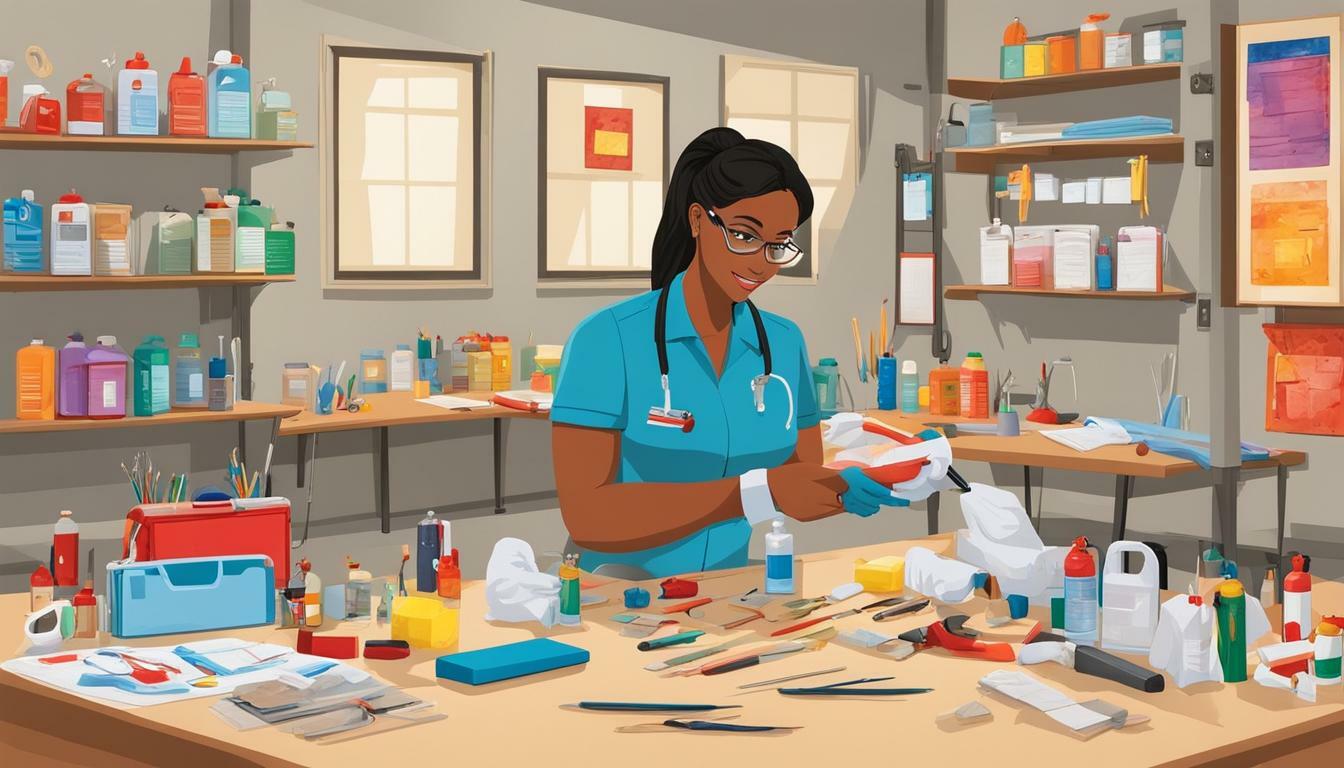
Overall, receiving first aid training is an essential step towards ensuring the safety of art teachers and their students. By acquiring basic first aid skills, art teachers can respond quickly and effectively to emergencies, potentially saving lives.
Maintaining a Safe Art Classroom
Ensuring safety in the art classroom is crucial for the well-being of students and teachers alike. In addition to having a properly stocked first aid kit, there are a variety of precautions that can be taken to promote creative space safety.
Safety Supplies for Art Teachers: One of the first steps in maintaining a safe art classroom is to provide teachers with the appropriate safety equipment. This can include gloves, protective eyewear, and aprons to prevent exposure to hazardous materials. Teachers should be trained on how to properly use and care for this equipment.
Proper Storage: Art materials should be stored in a safe and secure manner, away from heat sources and out of reach of children. Chemicals and other hazardous materials should be stored separately with clear labels and warnings. Proper ventilation should also be provided to minimize fume exposure.
Supervision and Clear Guidelines: Providing clear safety guidelines for students and ensuring that they are followed is critical in maintaining a safe art classroom. Teachers should always supervise students during art activities to ensure that safety protocols are being followed and any potential hazards are identified and addressed.
Regular Maintenance: Regularly inspecting and maintaining the art classroom, equipment, and first aid supplies is essential for preventing accidents. This can include checking that first aid kits are properly stocked and unexpired, maintaining equipment such as ventilation systems and fire extinguishers, and ensuring that all art supplies are in good condition.
Training: Finally, proper safety equipment for art teachers and regular maintenance will only be effective if teachers are trained to recognize and respond to potential emergencies. In addition to first aid training, teachers should also receive training on proper handling and disposal of hazardous materials and emergency procedures.
By implementing these safety measures, art teachers can create a safe and creative space for their students to learn, explore, and create. Remember, safety always comes first, and a little preparation can go a long way in preventing accidents and ensuring an enjoyable and productive learning experience.
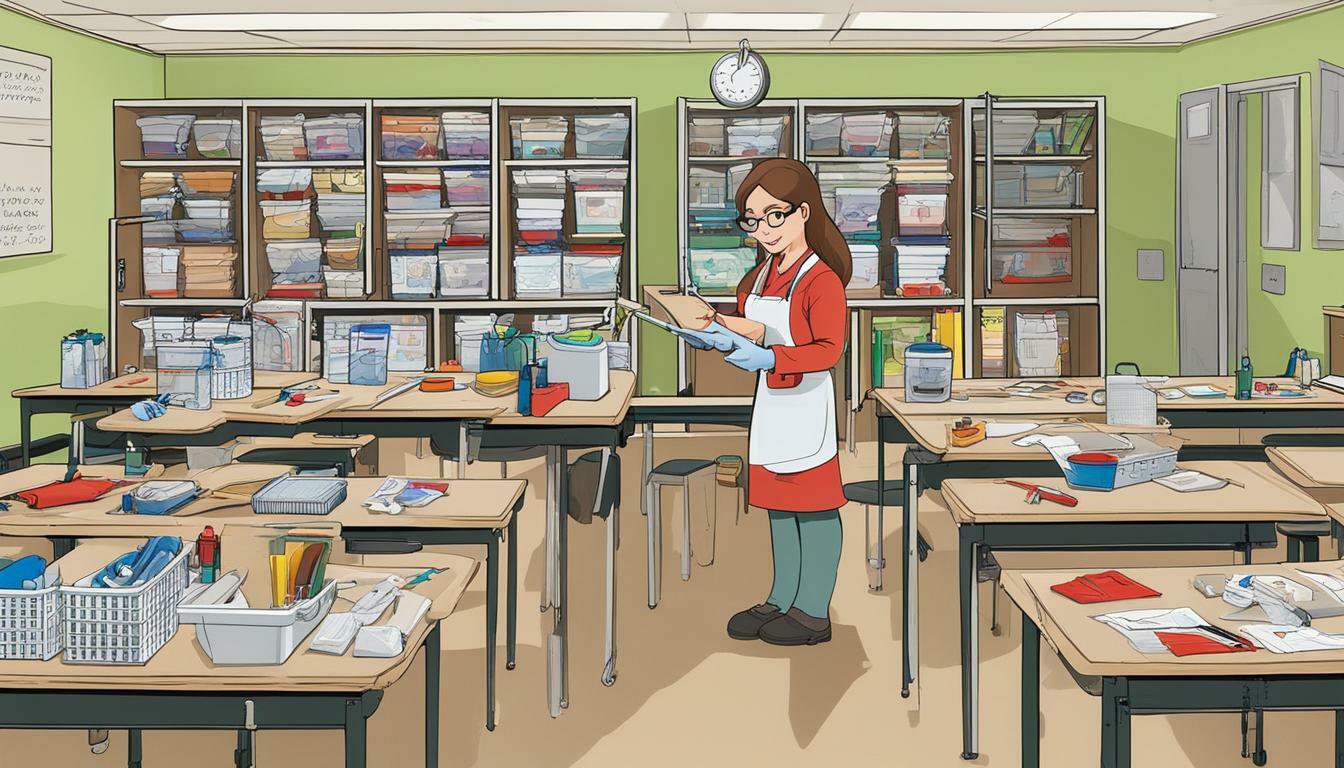
First Aid Kits and Regulations in the UK
When it comes to safety equipment for art teachers, first aid kits are one of the most important items that should be readily available in the classroom. In the UK, there are regulations and guidelines in place to ensure that workplaces, including schools and educational settings, have access to appropriate first aid equipment and trained personnel in case of emergencies.
For art classrooms, it’s important to consider the unique risks and hazards that may be present, and to ensure that first aid kits are tailored to the specific needs of the space. This may include providing supplies to address cuts, burns, eye injuries, and exposure to hazardous materials.
According to the Health and Safety Executive (HSE), the regulatory body responsible for health and safety in the workplace, employers have legal responsibilities to provide first aid equipment and personnel. In the context of art classrooms, this means that teachers and schools have a duty of care to ensure that adequate and appropriate first aid resources are available.
In addition to legal requirements, the HSE recommends that employers conduct a risk assessment to identify potential hazards and provide appropriate first aid resources. This includes identifying the size and layout of the worksite, the number of employees and students present, and the nature of the work being carried out.
Art teachers should also familiarize themselves with any specific guidelines or recommendations provided by their school or educational authority. This may include information on the types of injuries or incidents that are most likely to occur in the classroom, additional safety precautions to implement, or specific first aid supplies to include in a kit.
By staying informed about regulations and guidelines, art teachers can ensure that they are taking appropriate steps to create a safe and healthy learning environment for their students.

Where to Purchase First Aid Kits for Art Teachers
Art teachers need specialized first aid kits that cater to the unique needs of an art studio. These kits should include supplies such as burn creams, sterile dressings, adhesive bandages, eye wash, and gloves.
Many online retailers sell first aid kits specifically designed for art classrooms, such as FirstAid4sport and St John Ambulance. These kits can also be purchased from local suppliers or specialized providers that cater to the safety requirements of art classrooms.
When purchasing first aid supplies, it is essential to ensure that the products meet British standards and regulations. Look for products that comply with the Health and Safety (First Aid) Regulations 1981 and are CE marked.
It is also important to regularly check and update first aid kits to ensure that they are adequately stocked and ready for use in case of emergencies.
| Recommended suppliers of art classroom first aid kits: | Website: |
|---|---|
| FirstAid4Sport | https://www.firstaid4sport.co.uk |
| St John Ambulance | https://www.sja.org.uk |
| MedTree | https://www.medtree.co.uk |
Having access to the right first aid supplies is essential for addressing any accidents or emergencies that may occur in an art classroom. Purchasing a well-stocked first aid kit from a reputable supplier is a crucial step in ensuring the safety of art teachers and their students.
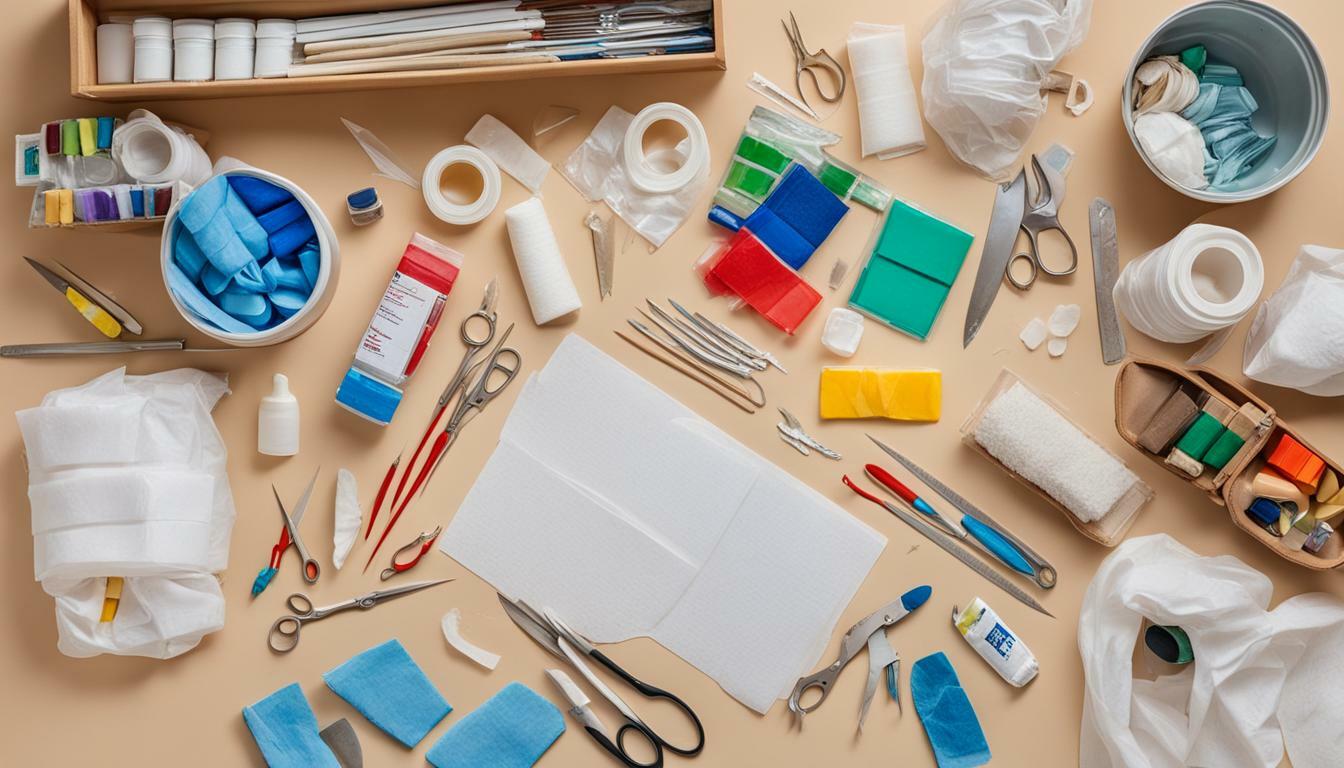
Incorporating First Aid Kits into Art Classroom Policies
Having a well-equipped first aid kit is essential for any art classroom, but it’s equally important to make sure that everyone in the room knows where it is and how to use it. Incorporating first aid kits into art classroom policies is an effective way to ensure that students, colleagues, and visitors are aware of the safety measures in place and can take appropriate action if an accident occurs.
One way to incorporate first aid kits into art classroom policies is to include them in the classroom rules and guidelines. This can be made explicit on the syllabus, a dedicated bulletin board in the classroom, or a handout given to students at the beginning of the semester. Inclusion of a list of emergency items in a student or staff handbook is another option. The goal is to make sure that anyone who enters the classroom knows that first aid kits are available, where they are located, and how to use them.
Another important aspect to consider when incorporating first aid kits into art classroom policies is the regular inspection and replenishment of supplies. It is important to check the first aid kit regularly to make sure that it contains all necessary items and that nothing has expired or run out. Keeping a log of inspection and maintenance can ensure that the first aid kit is always ready for use.
By incorporating first aid kits into art classroom policies, it sends a message to all students and colleagues that safety is a top priority. It also encourages everyone in the classroom to be proactive about their own safety and the safety of those around them. Remember, a well-stocked first aid kit combined with awareness and basic first aid training can save lives and prevent injuries in an emergency situation.

Regular First Aid Kit Inspections and Replenishment
Ensuring that your art room first aid kit is properly stocked and ready for use is crucial in maintaining a safe creative space. Regular inspections and replenishments of your first aid kit will help you avoid any emergencies that may arise due to outdated or depleted supplies.
Here is a checklist to help you keep track of your first aid kit supplies:
| First Aid Kit Item | Replenishment Schedule |
|---|---|
| Adhesive bandages of various sizes | Monthly |
| Sterile dressings and gauze pads | Monthly |
| Antiseptic wipes | Monthly |
| Burn creams and ointments | Quarterly |
| Eye wash | Quarterly |
| Gloves | Quarterly |
| Tweezers and scissors | Annually |
| Emergency blanket | Annually |
Regular inspections of your first aid kit will also help you identify any items that have expired or need to be replaced. It is important to dispose of any expired or damaged items immediately and replenish them with new supplies.
By following these guidelines for regular first aid kit inspections and replenishments, you can ensure that your art room first aid kit is always up to date and ready to handle any emergencies that may arise in your creative space.

Creating a Culture of Safety in Art Education
As art teachers, it is our responsibility to ensure the safety of our students, colleagues, and visitors in the art classroom. By promoting a culture of safety, we can create a space that not only fosters creativity but also prioritizes the physical well-being of everyone involved.
One of the most important aspects of promoting a culture of safety is ensuring that the necessary safety equipment is readily available in the art classroom. This includes first aid kits, eye wash stations, and any other safety supplies required for the specific tasks and materials used in the class. By having the necessary safety equipment on hand, we can quickly and effectively respond to any emergencies that may arise.
Another important way to promote a culture of safety is through education. As art teachers, it is essential that we receive proper first aid training and stay up to date on any new safety regulations or guidelines. Additionally, we must educate our students on safe and responsible practices, such as proper use and disposal of materials, and encourage them to speak up if they notice any unsafe conditions or practices.
We must also lead by example and consistently demonstrate safe practices in our own work. This can include wearing protective equipment such as gloves or aprons, properly labeling and storing materials, and providing adequate ventilation in the classroom to minimize exposure to harmful fumes or dust.
Overall, creating a culture of safety in art education is essential for promoting a safe and creative environment for everyone involved. By prioritizing the safety of our students and colleagues, we can ensure that the art classroom remains a space where creativity can flourish and everyone can feel empowered to explore their artistic passions.
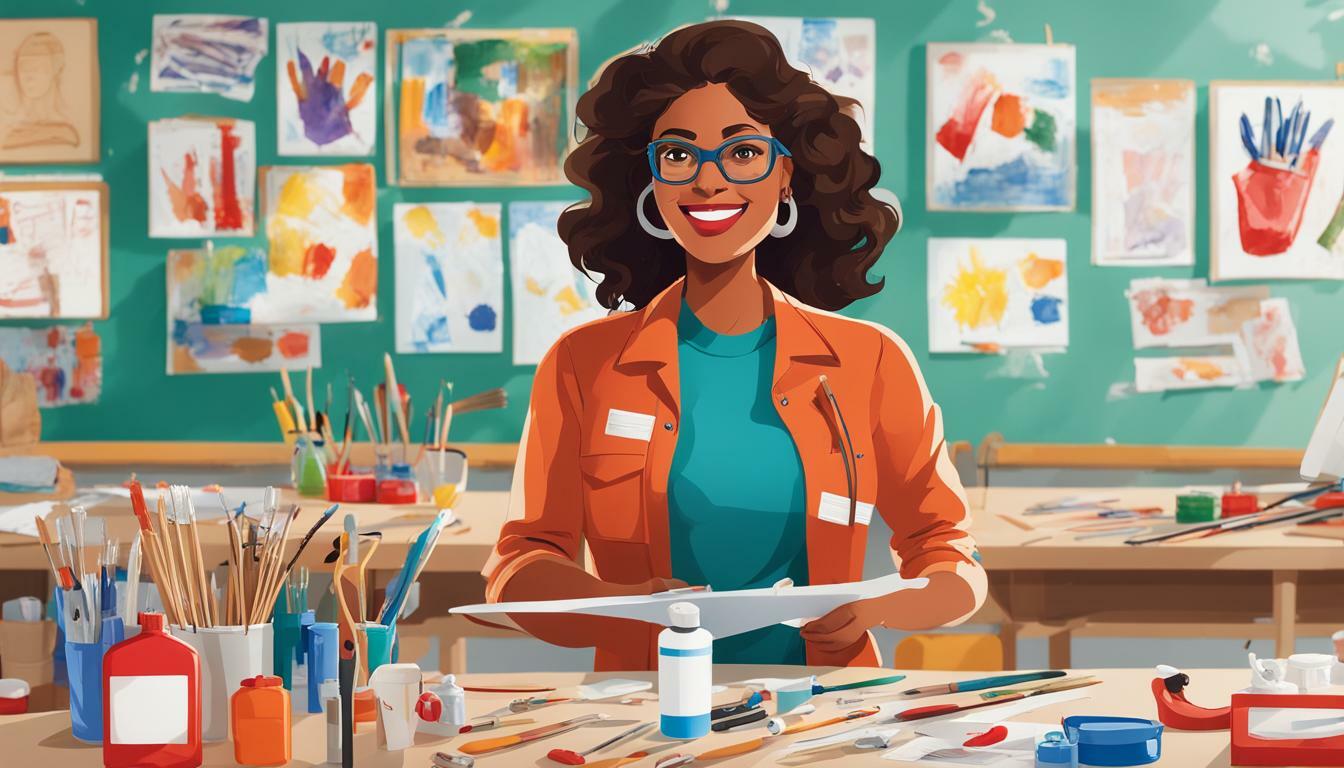
Ensuring Safety in the Art Classroom: First Aid Kits for Art Teachers
As an art teacher, the safety of your students and yourself should always be a top priority. One way to ensure this is to have a well-equipped first aid kit readily available in your classroom. Throughout this article, we have discussed the importance of first aid kits in art classrooms, the unique risks and hazards art teachers may encounter, and how to build a comprehensive kit. We have also covered the need for first aid training, maintaining a safe classroom, complying with regulations, and where to purchase kits.
By incorporating first aid kits and safety measures into the policies and procedures of your classroom, you can promote a culture of safety and creativity. It is vital to regularly inspect and replenish your first aid kit, communicate its presence and location to others, and ensure that your students and colleagues are aware of the safety guidelines and precautions in place.
Creating a Safe and Creative Space
As an art teacher, your goal is to create a safe and creative space for your students to express themselves and learn. By prioritizing safety and having the necessary first aid supplies on hand, you can ensure that any accidents or emergencies are addressed promptly and effectively.
Incorporating safety guidelines and precautions into your classroom policies can also lead to increased creativity and productivity. When students feel safe and secure, they are more likely to take risks and explore new ideas.
Conclusion
First aid kits for art teachers are an essential tool for creating a safe and creative space in the classroom. By understanding the unique risks and hazards of an art room, building a comprehensive kit, and providing first aid training to yourself and your colleagues, you can ensure the safety and wellbeing of your students. Remember to regularly inspect and replenish your kit, incorporate safety measures into your policies, and create a culture of safety and creativity in your classroom.
